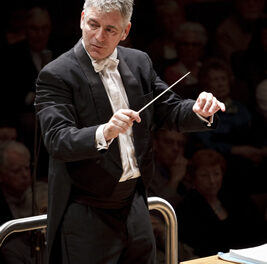Mendelssohn & Schumann Violin Concertos: Ludwig van Beethoven: Romances for violin and orchestra, No. 1 in G major, Op. 40, and No. 2 in F major, Op. 50, Felix Mendelssohn: Concerto in E minor for violin and orchestra, Op. 64; Robert Schumann: Concerto in D minor for violin and orchestra; Rachel Barton Pine, violin (Guarneri del Gesu, Cremona, 1742, “ex-Soldat” with titanium set-up), Göttinger Symphonie Orchester, Christoph-Mathias Mueller, cond.; Çedille CDR 9000 144, © 2103, 71:20, $16.00].
I began the first CD review that I wrote for CVNC with the question: “Does the world really need another recording of…” The arrival of this CD in my mailbox inevitably brought the same question to my mind concerning the Mendelssohn concerto (ArkivMusic lists some 240 others!), even though I am very familiar with and fond of the playing of this violinist, having heard her live and reviewed several of her earlier CDs, all of which I found outstanding. We learn in her booklet notes that she listened to the Mendelssohn from the time she began studying the violin at age 3 and a half, began learning it at age 8, and she plays it frequently on tour, so she has certainly had the time for it to ripen in her mind and under her fingers.
Indeed, she has understood its character and position as fitting between the classical and the romantic styles perfectly, and avoided the pitfall of the overly lush and saccharine performance to which many are seduced. Consequently, Pine makes it sound fresh even though it’s impossible to make it sound unfamiliar, and more like Mendelssohn than Brahms or Tchaikovsky. The balance with the orchestra is good, although without a personnel list it is unclear if the full forces shown in the stock photo of the orchestra on the accompanying booklet are being used. They take the work at a brisker tempo and Pine plays with less bite on the strings and less vibrato than is customary. Nonetheless, this is not a historically-informed performance, since titanium strings did not exist in 1845 when it premièred – Mendelssohn began working on it in 1838.
The Schumann, on the other hand, has been much less frequently played and recorded: ArkivMusic lists only 29 others, so it is relatively unfamiliar. The work, his last major one, was composed in two weeks in 1853 but never published or performed during Robert’s lifetime or for over 75 years afterwards because Clara and the dedicatee, Joseph Joachim, conspired to suppress it, thinking it unpolished and in need of more work. It was premièred in 1937 in Berlin, with Adolf Hitler and Joseph Goebbels in attendance, by Georg Kulenkampff, and then played in London by Jelly d’Arányi (Joachim’s grand niece) and in New York by Yehudi Menuhin, both of whom had argued over the rights to the first performance, but Nazi officials ruled both out. The CD project is an outgrowth of Mueller’s invitation to Pine to perform it with him and his orchestra in 2010, for which occasion Pine learned the work, and became enamored with it.
Its final movement presents some challenges in the form of tempi that fit the music being unplayable, so Pine made some minor changes, always following the principle of attempting to conceive of what Joachim would have done, based on her knowledge of his work with Brahms on his concerto, also dedicated to him, and of his own concerto. This work, too, is not a full-blown effusive romantic piece, although it is more so than the Mendelssohn, not surprising since Romanticism had progressed in the 15 years between the two. It is not in the same realm of excellence with the Mendelssohn, but rather in the second tier below the greatest. It is more dramatic and more traditionally structured with traditional differences among the movements compared to the Mendelssohn, which flows more as a seamless whole. It has no cadenza at the end of the first movement, in contrast with the Mendelssohn, whose cadenza is written out by the composer instead of being left to the soloist to devise. Pine handles it judiciously with reserve.
Pine had initially considered including on the CD a concerto by Ferdinand David, Mendelssohn’s dedicatee, concertmaster of the Gewandhaus Orchestra at the time, and Joachim’s teacher, but decided that none were of an equivalent caliber. Instead, she followed the suggestion of the CD’s producer, Grammy-winning Stephen Epstein, to use the Beethoven Romances, which she decided would be a good pairing, and they are, played in numerical but not chronological order. No. 1, published in 1803, separates the two concertos, and No. 2, published in 1805 but composed in 1798, concludes the CD; both it and the Schumann concerto seem to end abruptly, while No. 1 ends in a bit of a flourish like the Mendelssohn concerto.
The accompanying booklet is the standard Çedille quality. A photo of Pine graces the front cover; credits are on its inside, with track listings and timings on the facing page 3. Pine’s “Personal Note” that includes acknowledgements and thanks for the funders of the project occupies pages 4-7, and her program notes, pages 8-13; her bio follows on pages 14-15, Meuller’s on 16-17 accompanied by color photos of him and the orchestra, whose 150+-year history is found on page 18. Page 19 promotes a few of Pine’s other recordings and the back cover features her previous one, Violin Lullabies, with some critical appraisals.
I concluded my first-ever CD review by saying that I thought the world was richer because of what it offered. That is certainly true of this one as well because of its different and enlightening interpretation of the Mendelssohn in particular, but its fine rendering of the Schumann and Beethoven Romances as well. It’s another winner in Pine’s discography.
Note: Pine will perform again in North Carolina, in March, for the Raleigh Chamber Music Guild. For details, click here.












